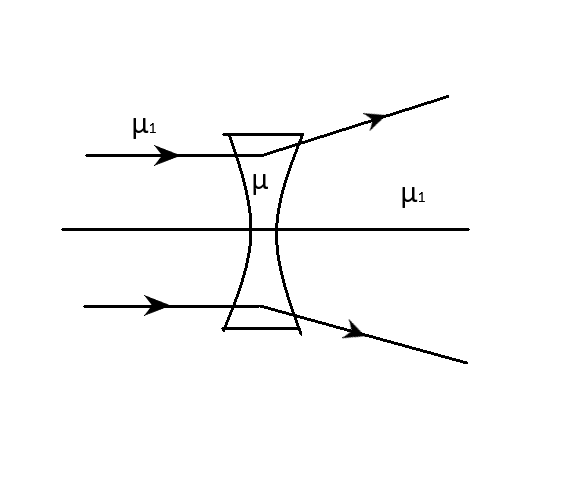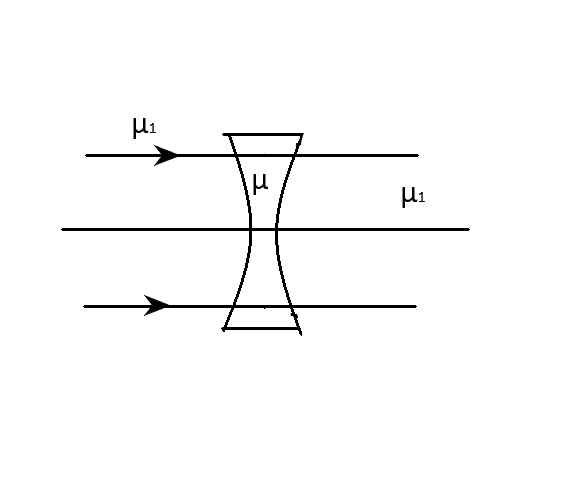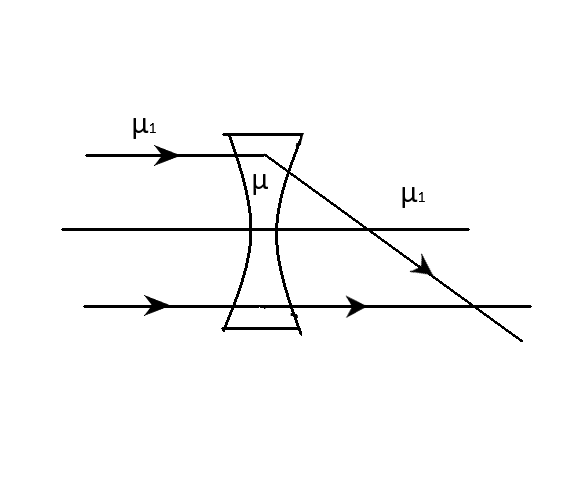
The refractive index of the material of a concave lens is \[\mu \]. It is immersed in a medium of refractive index \[{\mu _1}\]. A parallel beam of light is incident on the lens. The path of the emergent rays when \[{\mu _1} > \mu \] is:
A.

B.

C.

D.





Answer
545.7k+ views
Hint: When it is placed in the air, the concave acts as a diverging lens. This is because air has a lower refractive index than the lens. If the lens is placed in a medium with a higher refractive index, the situation reverses.
Complete step by step answer:
We are told that a concave lens is immersed in a medium of refractive index which is higher than the refractive index of the lens, itself. We are to choose the correct diagram for the emergent ray from the lens.
Generally, a concave lens when placed in air behaves as a diverging lens, hence the reason it is sometimes called a diverging lens. However, this is because air is a medium that has a lower refractive index than that of the material of the lens. When placed in a medium that has a higher refractive index, the refraction becomes the other way around. Hence, the concave lens behaves like a diverging lens. Thus, the emergent ray (refracted light) will diverge from one another as in B.
Hence, the correct option is B.
Note: For clarity, the emergent ray usually is the ray that comes out of a lens or block after been refracted, at least twice. For thin lenses, however, the refracted ray is the emergent ray, because that the light does not travel far enough to create a reasonable difference between first refraction and second refraction. In some cases, emergent ray is in the same direction as the incident ray, as in the case of a rectangular block.
Complete step by step answer:
We are told that a concave lens is immersed in a medium of refractive index which is higher than the refractive index of the lens, itself. We are to choose the correct diagram for the emergent ray from the lens.
Generally, a concave lens when placed in air behaves as a diverging lens, hence the reason it is sometimes called a diverging lens. However, this is because air is a medium that has a lower refractive index than that of the material of the lens. When placed in a medium that has a higher refractive index, the refraction becomes the other way around. Hence, the concave lens behaves like a diverging lens. Thus, the emergent ray (refracted light) will diverge from one another as in B.
Hence, the correct option is B.
Note: For clarity, the emergent ray usually is the ray that comes out of a lens or block after been refracted, at least twice. For thin lenses, however, the refracted ray is the emergent ray, because that the light does not travel far enough to create a reasonable difference between first refraction and second refraction. In some cases, emergent ray is in the same direction as the incident ray, as in the case of a rectangular block.
Recently Updated Pages
A man running at a speed 5 ms is viewed in the side class 12 physics CBSE

The number of solutions in x in 02pi for which sqrt class 12 maths CBSE

State and explain Hardy Weinbergs Principle class 12 biology CBSE

Write any two methods of preparation of phenol Give class 12 chemistry CBSE

Which of the following statements is wrong a Amnion class 12 biology CBSE

Differentiate between action potential and resting class 12 biology CBSE

Trending doubts
What are the major means of transport Explain each class 12 social science CBSE

Which are the Top 10 Largest Countries of the World?

Draw a labelled sketch of the human eye class 12 physics CBSE

How much time does it take to bleed after eating p class 12 biology CBSE

Explain sex determination in humans with line diag class 12 biology CBSE

When was the first election held in India a 194748 class 12 sst CBSE




